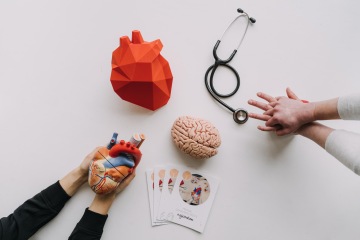Blood pressure
Blood flow pressures the walls of blood vessels. The force of blood pressure varies in different parts of the body.
The reading - blood pressure level - consists of two numbers separated by a slash. The first number refers to systolic blood pressure, the second number refers to diastolic.
There's a difference between:
- Low blood pressure, also called hypotension: readings are below 100/65
- High blood pressure, also called hypertension: readings are above 140/90
High blood pressure
High blood pressure is considered 140/90 mmHg (millilitres of mercury). About one in four Czechs have high blood pressure.
The root cause of it is not determined. It is a combination of risk factors in 90 % of cases.
What are the symptoms of it?
High blood pressure doesn't have its own specific symptoms. It develops over time - in months or years.
If it occurs, the symptoms might be:
- Headache
- Irritation
- Tiredness
- Dizziness
- Sleeping disorders
- Chest pain
- Heart pounding
How to prevent a high blood pressure?
Preventable risk factors:
- Smoking - If you quit smoking, the risk of having a heart attack or stroke lowers by up to 50%.
- Lack of exercise - Exercise regularly, at least 5 times a week for 30 minutes.
- Sleep - Sleep for at least 7 hours a day and go to bed (and from it) at the same time every day (yes, even at weekends :) )
- Diabetes - If you have diabetes, get checked by your doctor regularly
- Blood pressure - If you have high blood pressure, check it regularly and take your pills
Non-preventable risk factors:

- Gender - Men are more prone to both heart attack and stroke, women are more protected thanks to their sex hormones - estrogens.
- Age - The risk of having a stroke or a heart attack is higher after you turn 55.
- Genetics - If someone from your family had a stroke before the age of 55, tell that to your GP. Familial hypercholesterolemia, for example, is a hereditary disease, which can manifest at a young age.
FAQs
What to do when...
5 important steps to do when you have or see someone else having a heart attack or stroke.
- Don't panic, don't look for advice on the internet and start acting!
- Call 155 for help!
- Stay where you are and wait for an ambulance
- Is the patient conscious? Shoothe him/her. Check breathing and reactions (talk, pinch the patient's ear)
- Is the patient unconscious? Check breathing - tilt the patient's head back and see, if the chest is moving up and down. If the patient is not breathing, start chest compressions immediately!
What are the most common risk factors?
- Insufficient physical activity
- Obesity
- Unhealthy diet high in salt
- Alcohol consumption
- Smoking
How dangerous is high blood pressure?
- It doesn't cause physical pain, and that's a major disadvantage.
- It increases the risk of a heart attack, heart failure or stroke.
- The heart must beat harder because of the high pressure. It damages the walls of blood vessels, and such damage can lead to atherosclerosis.
- May damage kidneys, heart and retina.
- Blood vessels are more likely to burst (e.g., in the brain).
How to measure blood pressure?
We get our blood pressure checked by general practitioners (GP) during preventive health check-ups once every 2 years. We can also check it at home using a blood pressure monitor. You can buy one in a chemist or specialist shop. It's always better to get professionals' advice.
It's essential to stick with these rules when measuring blood pressure at home:
- You should be at rest at least 5 minutes before, and not smoke.
- It's best to do it while sitting still with your hand rested on a table.
- Monitor's cuff should be at the heart level and not too loose or too tight.
Don't fear if the readings are a little different each time. Blood pressure increases and decreases throughout the day, and it gets low at night.
What is systolic blood pressure?
What is diastolic blood pressure?
Is it true that smoking is harmful to health?
Yes, of course. Smoking:
- increases the risk of blood clots
- disrupts platelets' function
- increases the number of white blood cells
- reactive oxygen species are being produced and further damage the surface of blood vessels

